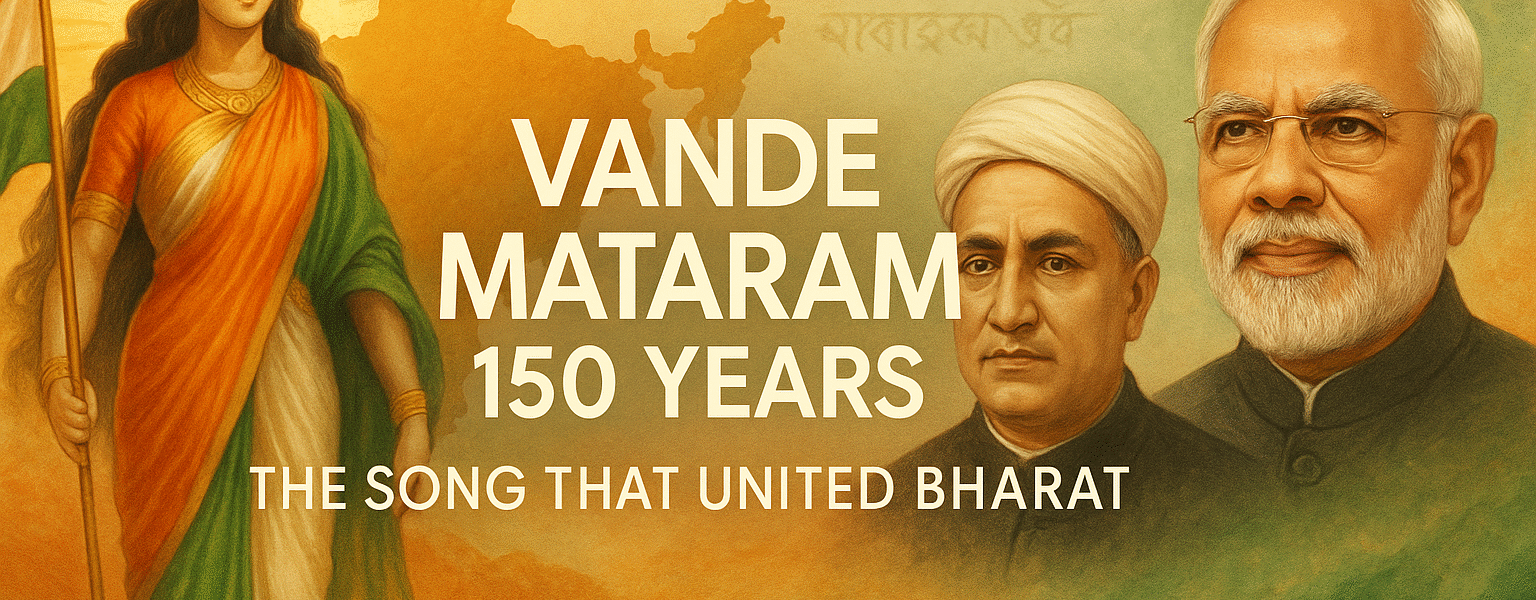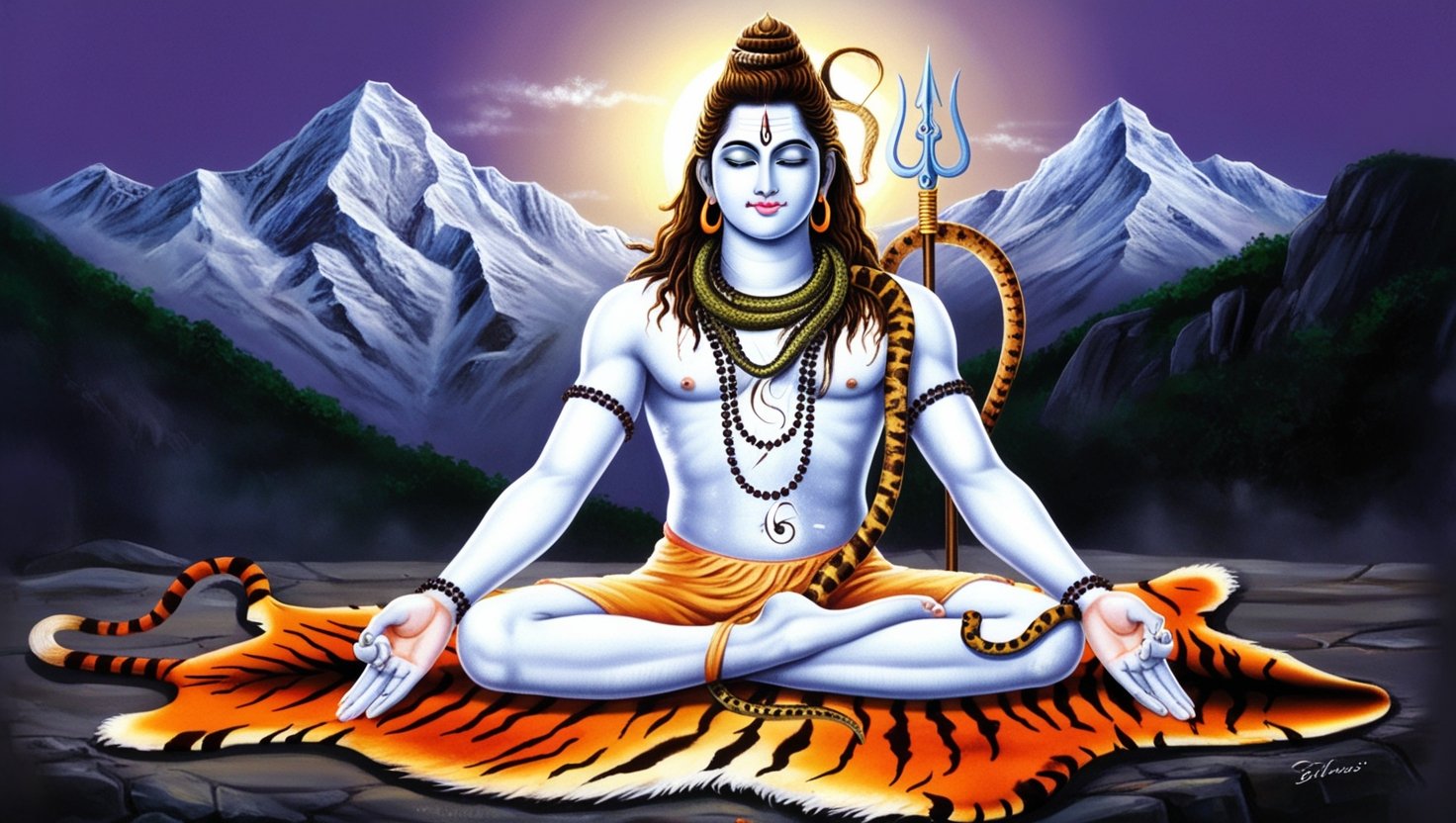Vande Mataram 150 Years: The Song That United Bharat — From Bankim Chandra’s Vision to Modi’s Revival of National Pride
As India marks the 150th anniversary of the song Vande Mataram (first published 7 November 1875) , the moment offers a timely opportunity to revisit how this hymn of reverence to the motherland came to be, how it played a powerful unifying role in the freedom struggle, how socio-political disputes shaped its trajectory, and what it means today for Bharat’s citizens.
The Birth of the Song
The poem was composed by Bankim Chandra Chattopadhyay (often spelt Chatterjee) and first published in the literary journal Bangadarshan in 1875, and later included in his novel Anandamath (1882).
The title “Vande Mātaram” literally means “I bow to thee, Mother” (from Sanskrit vande = I praise/offer respect, mātaram = mother). At its heart, it is an ode to the motherland, personified as the nurturing, powerful “Mother” that one bows to.
Initially, the “mother” image was rooted in Bengal (the novel’s setting), but the poem soon transcended region to become a pan-Indian symbol.
In 1896, the eminent poet Rabindranath Tagore recited it at the Indian National Congress session in Calcutta, which helped it gain popular and political traction.
From Literary Ode to Rallying Cry
During India’s fight for freedom, Vande Mataram became more than poetry — it was a war-cry of sorts. By 1905, it was widely sung in protest gatherings and became banned by the British in certain contexts, thereby signalling its power.
The Congress formally adopted the first two stanzas in October 1937 as the “National Song” (not to be confused with the national anthem) of India.
On 24 January 1950, the Constituent Assembly declared:
“…the composition consisting of the words and music known as Jana Gana Mana is the National Anthem of India… and the song Vande Mataram, which has played a historic part in the struggle for Indian freedom, shall be honoured equally with Jana Gana Mana…”
Thus, Vande Mataram holds an honoured place — the National Song — equally respected though distinct from the Anthem.
The 150-Year Celebration & Its Significance
In November 2025, the Government of India launched a year-long commemoration of Vande Mataram’s 150th anniversary. Across the country, mass sing-alongs, student gatherings, ceremonies and cultural events have marked the occasion — reaffirming the song’s enduring resonance as a symbol of unity and patriotism.
In this context, calls have been made to re-emphasise the song’s message of collective identity, shared heritage and national pride — beyond narrow communal or political frameworks.
The Contention: Why Only the First Two Stanzas?
Though the full poem contained more verses (including references to goddesses such as Durga and Kamala) , only the first two stanzas were adopted officially. Some reasons:
- The later verses personified the “Mother” as a goddess-figure (“Thou art Durga, ten-armed”, etc) and referenced Hindu iconography.
- Some sections of the Muslim community and the All‑India Muslim League (and leaders like Muhammad Ali Jinnah) opposed public recitation of the full song, citing potential conflict with their religious beliefs.
- To keep the song inclusive and non-sectarian for all citizens, the decision was taken to limit official singing to the first two stanzas.
So while the full poem remains available, in official practice only the first two stanzas are typically used.
Why the Song Can Be Seen as Inclusive and Unifying
1. Universal imagery of the Motherland:
The song addresses the “Mother” (motherland) in abstract, not referencing any one religion or sect in the first stanzas. The metaphors of rivers, wind, fields, and blossoming trees convey shared natural heritage.
2. Not about “my God vs your God”:
Unlike some divisive slogans that pit one faith’s deity against another’s, Vande Mataram is about reverence towards the land and the community as a whole. The opening lines speak of “Mother rich with thy hurrying streams, bright with thy orchard-gleams…”
3. Empowerment, not subjugation:
It evokes strength, renewal, vitality: “Cool with the winds of delight, dark fields waving…” (translation) . The focus is on the Motherland as nurturing, liberating and inspiring.
4. Freedom-struggle credentials:
It united people of different backgrounds under the banner of seeking independence from colonial rule. The emotive resonance cut across region, class, and culture.
5. Contemporary reaffirmation:
The 150-year celebration underscores its relevance in today’s plural India — not as a relic of a bygone era, but as a living reminder of our shared duty, identity and potential.
Addressing Critiques and Clarifying Misconceptions
- Critique: “The song favours one religion (Hinduism) and is therefore divisive.”
Clarification: While later verses include goddess references, the official version (first two stanzas) is free of explicit sectarian or theological claims. The figure of the Mother is metaphorical, not a specific deity exclusive to one faith. Scholars note that the first verses make abstract reference to the motherland without any religious connotation. - Critique: “It was replaced because it could not represent minorities.”
Clarification: The reduction to two stanzas was a practical compromise to preserve inclusivity in a plural society. It is still honoured alongside the national anthem — emphasising equal respect. - Critique: “Why keep it at all if it is controversial?”
Clarification: The historic significance, emotional resonance, and capacity to foster national unity justify retaining it — with sensitivity to its inclusive interpretation.
What Every Line Means for the Citizen of Bharat
(Here we consider the first two stanzas, which are the officially recognised part.)
“Vande Mātaram! Sujalam suphalaam, Malayajashītalaam, Shasya-shyāmalaam Mātaram!”
- I bow to thee, Mother!
- Rich with thy hurrying streams, bright with thy orchard-gleams,
- Cool with the winds of delight, dark fields waving, Mother of might, Mother free.
- Meaning: The citizen bows in respect to the land, acknowledges its fertility (rivers, orchards), its cool refreshing breeze, the waving fields — all symbols of bounty and life. “Mother of might, Mother free” conveys that the land is powerful and liberated, and we pledge to uphold that freedom.
- For the citizen: It is a call to “respect and love the land that sustains us, take pride in its richness and work to maintain its freedom and strength.”
“Shubhra-jyotsnā-pulakitayāmīnīm, Phulla-kusumita-drumadala-shobhinīm, Suhāsinīṃ sumadhura-bhāshiṇīm, Sukhadaṃ varadaṃ Mātaram!”
- Clad in thy blossoming trees, Laughing low and sweet, Mother, to thee I bow.
- In thy soul, with jewelled hair and thy glorious smile divine, Loveliest of all earthly lands, Showering wealth from well-stored hands! Mother, Mother mine! Mother sweet, I bow to thee, Mother great and free!
- Meaning: This verse deepens the personal connection: the land is made beautiful by its trees and blossoms; the “Mother” smiles, is effortlessly generous (“showering wealth”), and is supremely lovable. The citizen’s tone is affectionate, reverential, and intimate.
- For the citizen: It invites an emotional bond, not just a formal duty, to care for the land as one would a mother, cherish its beauty, protect its generosity, be proud of its greatness and freedom.
In sum, every meaningful phrase is an invitation to love the land, respect its gifts, pledge to its freedom — without naming any creed or excluding any community.
How the Concept of “Shakti” Appears — And Why It’s Not Exclusionary
The full poem (in later stanzas) invokes goddesses like Durga (“Thou art Durga, ten-armed”), Kamala (lotus symbol) and mentions shakti (divine power) and bhakti (devotion).
In this metaphorical frame:
- The motherland is endowed with sacred power (shakti) — she is strong, protective, vibrant.
- The invocation of “shakti” is not aimed at one religion’s goddess, but the universal idea of strength — of the land, of its people, of the collective aspiration for freedom.
- Thus, the notion of “worship” is not about seeking sectarian vantage but about acknowledging the power of the land and the people.
Therefore, it need not (and historically did not) become a source of hatred between sects — instead, it provided a higher common ground of love, respect, duty and collective identity.
Why the 150-Year Mark Matters
- It reminds us that the song preceded modern India, that its origin lies in 19th-century Bengal and the early stirrings of nationalism.
- It reminds us of the sacrifices and struggles of freedom fighters who used this song as a unifier in the face of colonial rule.
- It provides a moment to reflect: Are we living up to the ideals of unity, freedom, respect for the motherland, and shared destiny that the song evokes?
- It offers a chance to reaffirm that national identity in a plural country like Bharat is not about erasing differences but weaving them into shared purpose and respect.
In Context: Political Ambitions, Religious Division & National Song
It is true that in the decades before independence, communal and political divisions sharpened: figures like Jinnah opposed the full recital of Vande Mataram, seeing in some verses allegiances inconsistent with their vision of India.
Some secular nationalist leaders and thinkers argued for the primacy of other lyrics (for instance, Jana Gana Mana) because of concerns about inclusive representation. The decision to adopt only the first two stanzas of Vande Mataram reflected this compromise.
Nevertheless, many historians now see that by clipping those later verses, the song’s core remained intact — the reverence to motherland, the call to unity, and the empowerment of citizens. The narrowing was less about rejecting the song than widening its accessibility.
Today, when the Prime Minister Narendra Modi and the government emphasise commemorative events for Vande Mataram, the underlying thought is that one of the great unifying songs of Bharat cannot be allowed to fade or be sidelined simply because of past political divisions. The idea is to bring back its spirit of shared belonging, not of enforced uniformity.
Closing Reflections
- Vande Mataram is not a relic; it is a living song, meant to evoke pride, purpose and unity in the citizens of India.
- Its core message is inclusive: the land belongs to all who dwell on it; we bow with respect, we pledge with love, we serve with duty.
- While historical realities meant contestation and compromise, the fundamental virtue of the song remains — that the “Mother” is the land, and we her children, together.
- At a time when societies everywhere face fragmentation, revisiting this song’s message of common heritage, shared responsibility, and uplifted collective will is timely and important.
- For any citizen of Bharat, understanding every word of the song — the imagery of river, orchard, tree, breeze — means acknowledging: “This land nurtures me; I shall safeguard its freedom, beauty and dignity.”
#VandeMataram150 #BankimChandra #BharatMata #NationalSong #IndianFreedom #PMModi #Patriotism #UnityInDiversity #IndianHeritage #VandeMataram #BharatRising
Vande Mataram 150 years, Bankim Chandra Chattopadhyay, Vande Mataram history, meaning of Vande Mataram, national song of India, Narendra Modi Vande Mataram, Vande Mataram controversy, Vande Mataram translation, Bharat unity song, Vande Mataram celebration 2025, 150th anniversary of Vande Mataram, Shakti in Vande Mataram, Bankim Chandra patriotism, Indian freedom struggle songs, Vande Mataram vs Jana Gana Mana
Discover more from
Subscribe to get the latest posts sent to your email.







